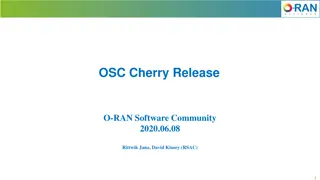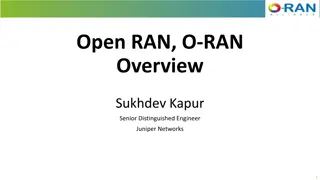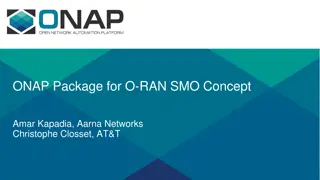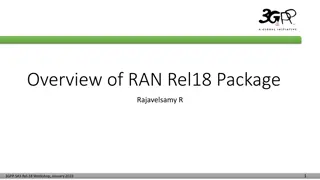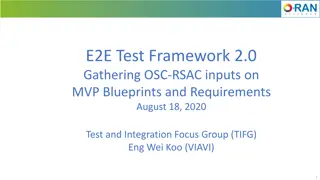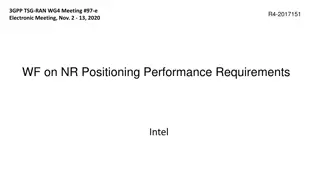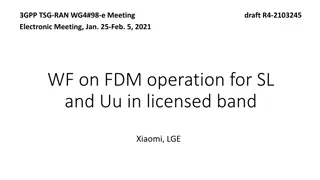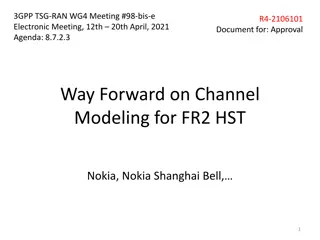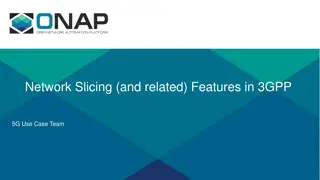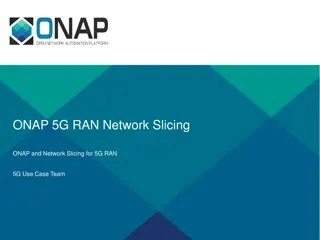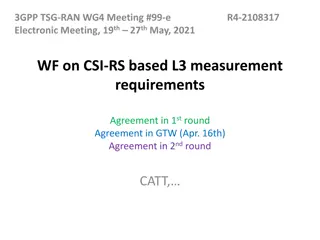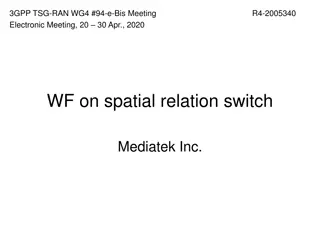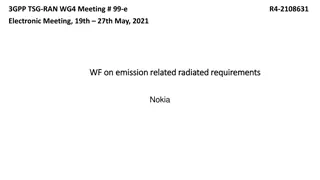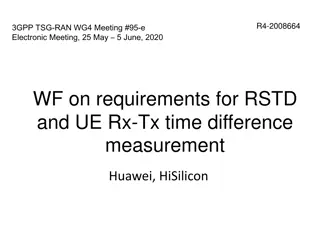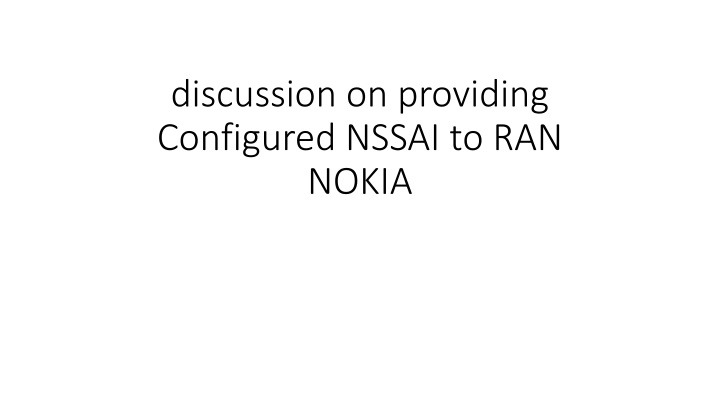
Providing Configured NSSAI to RAN Nokia - RFSP Index and Allowed NSSAI Calculation
Learn how the RFSP Index is sent to RAN along with Allowed NSSAI calculation in the context of providing Configured NSSAI to RAN Nokia. Understand the importance of optimizing RFSP based on Allowed NSSAI for efficient UE-specific Idle mode camping policies.
Download Presentation

Please find below an Image/Link to download the presentation.
The content on the website is provided AS IS for your information and personal use only. It may not be sold, licensed, or shared on other websites without obtaining consent from the author. If you encounter any issues during the download, it is possible that the publisher has removed the file from their server.
You are allowed to download the files provided on this website for personal or commercial use, subject to the condition that they are used lawfully. All files are the property of their respective owners.
The content on the website is provided AS IS for your information and personal use only. It may not be sold, licensed, or shared on other websites without obtaining consent from the author.
E N D
Presentation Transcript
discussion on providing Configured NSSAI to RAN NOKIA
How is the RFSP Index sent to RAN with the How is the RFSP Index sent to RAN with the Allowed NSSAI calculated? Allowed NSSAI calculated? Today, the RAN can determine the UE-specific CellReselectionPriorites it sends to the UE in the RRC Connection Release message based on the RFSP and the Allowed NSSAI of the UE. RFSP in use is determined by AMF e.g. by using the PCF Npcf_AMPolicyControl_Create service operation by taking as input the Subscribed RFSP (which the HPLMN UDM sends to the AMF) and the Allowed NSSAI. RFSP Index = f(RFSP Indexsubscribed , Allowed NSSAI) subscribed RFSP Index, the Allowed NSSAI are optional inputs of Npcf_AMPolicyControl_Create service operation which has output as in following slide
How is the RFSP Index sent to RAN with the Allowed NSSAI calculated? 23.503 Table 6.5-1: Access and mobility related policy control information Information name Description Category PCF permitted to modify in a UE context in the AMF Yes Scope UE-AMBR This defines the UE-AMBR value that applies for a UE This part defines the service area restrictions List of allowed TAIs (NOTE 3) (NOTE 4). List of non-allowed TAIs (NOTE 3). The maximum number of allowed TAIs. (NOTE 4) This part defines the RFSP index Defines the RFSP Index that applies for a UE This part defines the SMF selection management instructions Defines if a UE requested unsupported DNN is requested for replacement by PCF Conditional (NOTE 5) UE context Service Area Restrictions List of allowed TAIs. List of non- allowed TAIs. Maximum number of allowed TAIs RFSP Index Conditional (NOTE 1) Conditional (NOTE 1) Conditional (NOTE 1) Yes UE context Yes UE context Yes UE context The RFSP Index defines the RFSP Index for radio resource management functionality. RFSP Index Conditional (NOTE 2) Yes UE context SMF selection management This index points to connected and idle mode policies in the RAN. DNN replacement of unsupported DNNs List of S- NSSAIs Conditional (NOTE 6) Yes UE context Defines the list of S-NSSAIs containing DNN candidates for replacement by PCF Defines UE requested DNN candidates for replacement by PCF If service area restrictions is enabled. If RFSP index is enabled. Either the list of allowed TAIs or the list of non-allowed TAIs are provided by the PCF. Both the maximum number of allowed TAIs and the list of allowed TAIs may be sent by PCF. If UE-AMBR is enabled. If SMF selection management by PCF is enabled. The List of S-NSSAIs contains S-NSSAIs, valid in the serving network, of the Allowed NSSAI. Conditional (NOTE 6) (NOTE 7) Conditional (NOTE 6) Yes UE context However this is based on Allowed NSSAI + Subscribed RFSP and in general cannot be also consider, for Idle mode camping policies, the set of slices the UE could potentially use (the Configured S-NSSAIs). Per S-NSSAI: List of DNNs Yes UE context NOTE 1: NOTE 2: NOTE 3: NOTE 4: NOTE 5: NOTE 6: NOTE 7:
Why is the current RFSP Index sent to RAN not sufficient? The RAN can decide UE-specific Idle mode camping policies based on the pair (Allowed NSSAI, RFSP Index) However, RFSP Index = f(RFSP Index subscribed , Allowed NSSAI) So, the RFSP-Index is conditioned to optimally serve the Allowed NSSAI based on the above. The RAN has no information on what slices the UE could potentially use (the Configured NSSAI) nor an RFSP Index based on the Configured NSSAI. For us, the RAN should be optionally able to receive information to provide the UE with Camping policies that can also take into account the slices the UE can potentially use. The RFSP Index as defined today cannot convey the same benefit as otherwise we should have that the RFSP Index is related to the Configured NSSAI and not the Allowed NSSAI. That would mean that, irrespective of the Allowed NSSAI provided to the PCF, the PCF outputs the same RFSP Index that is related to the configured NSSAI, which also means that the Allowed NSSAI is not a meaningful parameter to be sent to the PCF to derive the RFSP Index. If however for some values of Allowed NSSAI a different RFSP Index exists and in particular for some value of the Allowed NSSAI we have f(RFSP Index subscribed , Allowed NSSAI) != f(RFSP Index subscribed , Configured NSSAI) then there is benefit for the RAN to consider the additional information as the RAN may decide it is better to let the UE camp on the bands of the Configured NSSAI than a more specific band for the Allowed NSSAI only (taking into account many factors including RAN status, cells neighbouring with the current cell, and other policies the RAN implements which cannot be exported to the CN). It has to be decided whether the RFSP Index and camping policies are the same whichever the Allowed NSSAI, for a Given Configured NSSAI for a UE (in which case the Allowed NSSAI has no value as input to the PCF for RFSP Index decision), or whether RFSP Index and camping policies can be different for the Allowed NSSAI and Configured NSSAI for a UE. If they can be different, it is proposed it is beneficial to provide the Configured NSSAI and related RFSP index to the RAN as ADDITIONAL information for RRM
Why is it beneficial to send configured NSSAI also for UE impacting solutions RAN2 is discussing? The RAN can provide the UE with slice specific Camping policies/priorities in RRC connection release. By knowing the Configured NSSAI, the RAN can provide all the information the UE needs to perform any reselection within the bands set valid for Configured Slices there is no use to provide the UE with all the information on all bands available, and it too is restrictive to just provide the Allowed NSSAI bands as then the UE would not be able to camp on the bands of Intended slices and so the result is that we have like for pre-Rel-17 UEs the same need to use Target NSSAI (so what is the benefit of impacting the UE?) It is beneficial to provide the Configured NSSAI and its related RFSP Index to the RAN also for rel-17 UE impacting solutions



